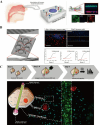Innovative organ-on-a-chip platforms for exploring tumorigenesis and therapy in head and neck cancer
- PMID: 40671128
- PMCID: PMC12269115
- DOI: 10.1186/s12967-025-06824-5
Innovative organ-on-a-chip platforms for exploring tumorigenesis and therapy in head and neck cancer
Abstract
Background: Head and neck cancer (HNC) presents significant research challenges due to the complexity of its tumor microenvironment (TME) and the heterogeneity across different cancer subtypes. Recent advancements in three-dimensional (3D) culture models and organ-on-a-chip (OOC) technology offer new avenues for mimicking the TME and enhancing the study of tumor biology, drug responses, and personalized treatment strategies. This study aims to summarize the current state of these models in HNC research and their potential in bridging the gap between preclinical models and clinical applications.
Methods: This review synthesizes findings from recent literature on the use of 3D models such as tumor spheroids, organoids, and co-culture systems in HNC research. A focus is placed on their applications in different cancer types, including laryngeal, oral, and nasopharyngeal cancers. Additionally, the integration of OOC technology in studying cancer metastasis, immunotherapy, and radiotherapy is discussed. Relevant studies on the role of AI and robotics in improving model efficiency and scalability are also examined.
Results: The review identifies key developments in 3D model systems and OOC technologies, highlighting their ability to replicate patient-specific tumor behaviors and predict therapeutic responses. While these models have advanced the understanding of HNC pathophysiology, challenges remain in terms of technical limitations, validation, and physiological relevance. The integration of AI and robotics has shown promise in enhancing the scalability and data analysis capabilities of these models.
Conclusions: Advancements in 3D and OOC technologies are essential for overcoming the current limitations in HNC research. These models offer valuable insights into tumor biology and therapeutic efficacy, and their integration with artificial intelligence (AI) can further accelerate the development of personalized treatment strategies. However, further validation and refinement are needed before these models can be widely translated into clinical practice, offering a more effective and individualized approach to treating HNC.
Keywords: Head and neck Cancer (HNC); Organ-on-a-Chip (OOC); Personalized medicine; Three-Dimensional models (3D); Tumor microenvironment (TME).
© 2025. The Author(s).
Conflict of interest statement
Declarations. Ethics approval and consent to participate: Not applicable. Consent for publication: All authors agreed to publish this review. Competing interests: The authors declare no conflict of interest.
Figures






Similar articles
-
Innovations in cancer treatment: evaluating drug resistance with lab-on-a-chip technologies.Int J Pharm. 2025 Sep 15;682:125936. doi: 10.1016/j.ijpharm.2025.125936. Epub 2025 Jul 5. Int J Pharm. 2025. PMID: 40623610 Review.
-
Management of urinary stones by experts in stone disease (ESD 2025).Arch Ital Urol Androl. 2025 Jun 30;97(2):14085. doi: 10.4081/aiua.2025.14085. Epub 2025 Jun 30. Arch Ital Urol Androl. 2025. PMID: 40583613 Review.
-
From spheroids to organoids: next-generation models for CAR-T cell therapy research in solid tumors.Front Immunol. 2025 Jul 11;16:1626369. doi: 10.3389/fimmu.2025.1626369. eCollection 2025. Front Immunol. 2025. PMID: 40718488 Free PMC article. Review.
-
Systemic Inflammatory Response Syndrome.2025 Jun 20. In: StatPearls [Internet]. Treasure Island (FL): StatPearls Publishing; 2025 Jan–. 2025 Jun 20. In: StatPearls [Internet]. Treasure Island (FL): StatPearls Publishing; 2025 Jan–. PMID: 31613449 Free Books & Documents.
-
Accreditation through the eyes of nurse managers: an infinite staircase or a phenomenon that evaporates like water.J Health Organ Manag. 2025 Jun 30. doi: 10.1108/JHOM-01-2025-0029. Online ahead of print. J Health Organ Manag. 2025. PMID: 40574247
References
-
- Syrjanen S. The role of human papillomavirus infection in head and neck cancers. Ann Oncol. 2010;21(Suppl 7):vii243–5. - PubMed
Publication types
MeSH terms
Grants and funding
- No. 2023030514/Ningbo Top Medical and Health Research Program
- No. 2022L005/Ningbo Clinical Research Center for Otolaryngology Head and Neck Disease
- 2025KY221/Medical and Health Research Project of Zhejiang Province
- 2025KY222/Medical and Health Research Project of Zhejiang Province
- Grant No.82341032/National Natural Science Foundation of China
LinkOut - more resources
Full Text Sources
Medical
Miscellaneous

